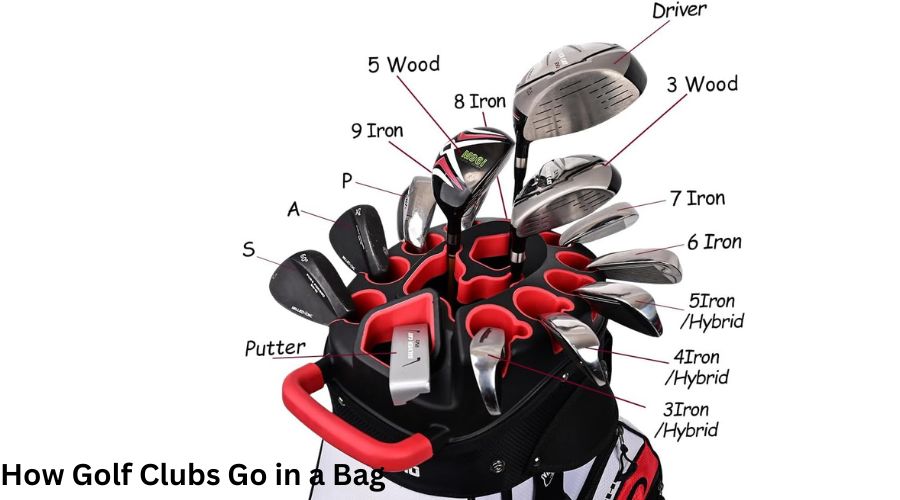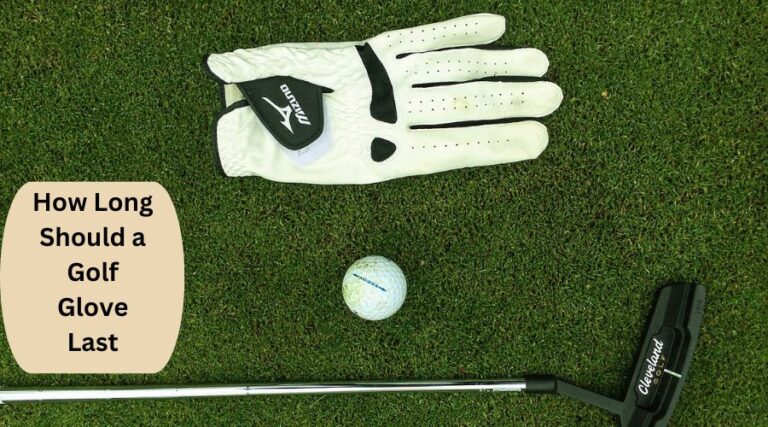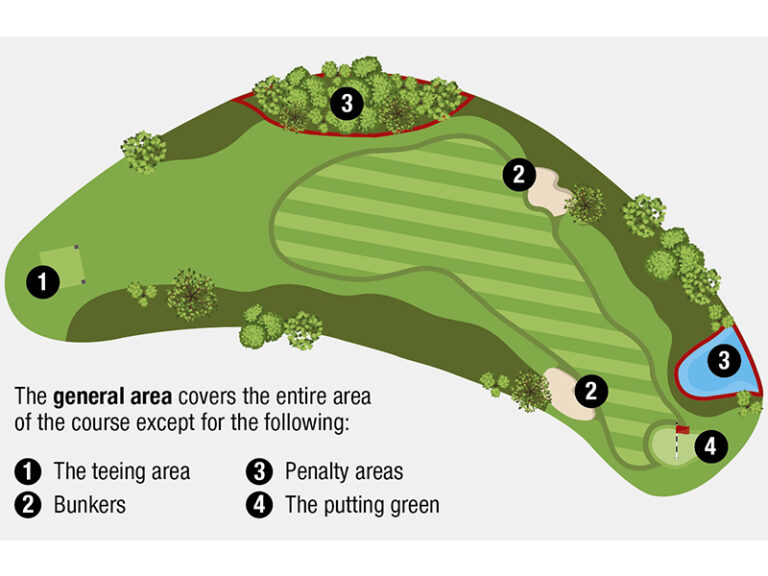Golf clubs are organized in a bag from longest to shortest, with woods at the top. Drivers and woods occupy the back slots, while irons descend in order from there.
Organizing your golf bag efficiently can make a difference on the course. A well-arranged bag keeps your clubs accessible and protected. Start with the longest clubs in the back and proceed to the shortest at the front. Woods and drivers typically sit at the top of your bag, making them easy to grab.
Irons follow in descending order, ensuring a smooth transition as you move through the game. Your wedges and putter will find their place near the bottom, ready for precision shots. This setup not only streamlines your play but also helps maintain your clubs’ condition. Remember, a tidy golf bag reflects a player’s care for the sport and their equipment.
Contents
The Basics Of Golf Bag Organization
Understanding The Basics of Golf Bag Organization is crucial for any golfer. A well-organized bag promotes efficiency and ease of access on the course. It also protects clubs from damage. Let’s dive into the traditional way to arrange clubs and explore how to tailor it for personal convenience.
The Traditional Layout
Golf bags are designed with a top divided into sections. Clubs go from the longest to the shortest, from the back to the front of the bag. This layout follows a systematic approach to club selection.
- Drivers and woods are placed in the back compartments.
- Long irons (2, 3, 4) sit in the middle sections.
- Mid and short irons (5, 6, 7, 8, 9) are next, going towards the front.
- Wedges and putter occupy the front slots for easy access.
This traditional method ensures that the taller clubs are at the top of the bag, which helps to protect the smaller, more delicate clubs like the putter and wedges.
Customizing For Convenience
While the traditional layout works well, customizing your golf bag to fit your style can make a big difference. Consider these tips:
- Place your most-used clubs where they are easiest to reach.
- Group clubs by use case, such as putting all ‘around the green’ clubs together.
- Adjust the order based on the course layout and your game strategy.
Remember, the key is to know where each club is without having to look, saving time and keeping your focus on the game.
Club Segregation By Type
Understanding how to organize golf clubs in a bag can improve your game. Club segregation by type ensures easy access and protection for your equipment. Let’s delve into the specifics of arranging woods and irons.
Woods: Power At The Top
Positioning your woods at the top of the bag is crucial for a smooth start. These clubs, including the driver, are your game’s powerhouses. They are longer and therefore should sit in the top compartment of your golf bag for easy access and to prevent damage.
- Driver – Place it in the very first slot for maximum reach.
- Fairway Woods – Store next to the driver, ready for longer shots from the fairway.
- Hybrids – If used, they go alongside the fairway woods.
Irons In The Middle: Precision Matters
Irons require precise placement in the middle of the bag. This tiered arrangement aligns with their use for various distances and shots. Shorter irons offer control, while longer irons provide distance.
| Club Type | Location in Bag |
|---|---|
| Long Irons (2-4) | Top-middle section |
| Mid Irons (5-7) | Center section |
| Short Irons (8-PW) | Bottom-middle section |
Organizing irons from longest to shortest in descending order helps maintain balance and efficiency in your game.
Specific Slot Assignments
Organizing your golf bag is key to a smooth game on the course. Knowing where each club should go saves time and protects your equipment. Let’s explore the specific slot assignments for each type of club.
Driver’s Prime Spot
Place your driver in the topmost compartment. This spot is designed for the longest club, providing easy access and protection. Keep it separate from other clubs to prevent damage.
Fairway Woods And Hybrids
Right below the driver, the fairway woods and hybrids find their home. Arrange them by length with the longest just below the driver. This orderly setup ensures you can quickly select the right club.
Irons: Order Of Use
The middle section is reserved for irons. Start with the longest iron on the left, moving to the shortest on the right. This arrangement matches the natural progression of use on the course.
Table of Irons Order
Add rows as needed for remaining irons
| Slot | Iron |
|---|---|
| 1st | Longest Iron (2, 3, or 4) |
| 2nd | 5-Iron |
| 3rd | 6-Iron |
End of the HTML content for the blog post section
Wedges And Putter Placement
Organizing your golf bag properly can make a big difference on the course. Specifically, placing your wedges and putter correctly enhances both accessibility and game efficiency. Let’s dive into the best practices for organizing these essential clubs.
Wedges: Accessible And Organized
Wedges are vital for short-distance shots and need to be readily accessible. Here’s how to organize them:
- Place wedges in the middle section of your bag.
- This position allows easy access after using longer clubs.
Keeping wedges together maintains order and speeds up club selection. Also, ensure they are free from tangles with other clubs.
Putter: The Final Touch
The putter has a unique role and needs a specific spot in your bag:
- Store your putter in a dedicated putter well if your bag has one.
- If not, place it next to your wedges for minimal interference.
This placement prevents damage to the putter’s delicate grip and head. It also keeps it handy for when you reach the green.
Properly organizing your wedges and putter not only protects your equipment but also shaves valuable seconds off your play time, keeping your game sharp and focused.
Golf Bag Variations
Understanding the different types of golf bags is crucial for any golfer. Choosing the right one can enhance your game and protect your clubs. Let’s explore the variations and features that make each golf bag unique.
Stand Bag Versus Cart Bag
Stand bags are lightweight and designed for golfers who prefer to walk the course. These bags have two retractable legs to keep the bag upright. Cart bags are bulkier and made for riding in a golf cart. They have more storage space but are heavier.
| Feature | Stand Bag | Cart Bag |
|---|---|---|
| Weight | Light | Heavy |
| Legs | Yes | No |
| Storage | Less | More |
| Use | Walking | Riding |
Benefits Of Individual Dividers
- Protects club grips from tangling and wear.
- Speeds up club selection with easy organization.
- Reduces noise from clubs clashing.
Accessorizing Your Golf Bag
Every golfer knows that a well-organized bag can make all the difference on the course. But beyond the clubs, your bag can be a treasure chest of game-enhancing accessories. Let’s explore how to deck out your bag with essentials that could shave strokes off your game.
Essential Accessories
Before you hit the links, make sure your golf bag is equipped with these must-haves:
- Golf Gloves – A good grip is crucial.
- Balls and Tees – Stock up to avoid running out.
- Ball Markers – Keep it handy for the greens.
- Divot Repair Tool – Protect the course and fix your marks.
These items are non-negotiable for any serious golfer. Keep them within easy reach for a stress-free game.
Optimizing Pocket Use
Your golf bag’s pockets are there to serve you. Use them wisely:
| Items to Store | |
|---|---|
| Top Pocket | Valuables like wallet and phone |
| Side Pocket | Rain gear and extra clothing |
| Front Pocket | Snacks and energy bars |
| Bottom Pocket | Golf balls and tees |
Organize each pocket for easy access and balance the weight across your bag. This makes carrying your bag easier and helps you find what you need quickly.
Loading And Carrying The Bag
Mastering the art of loading and carrying a golf bag is essential for any golfer. A well-packed bag ensures easy access to your clubs and accessories, while proper carrying technique can save you from strain and discomfort. Follow these steps to optimize your golf bag setup.
Proper Loading For Transport
To ensure your clubs are safe and organized, start with these simple steps:
- Place the driver and woods at the back of the bag. These are the tallest clubs.
- Add your irons in descending order, from the longest to the shortest.
- Position the wedges next, followed by the putter in the front-most section.
- Ensure all clubs face the same direction for easy removal and replacement.
By following this order, you protect your clubs and maintain balance in the bag.
Strap Adjustments For Comfort
Adjusting your golf bag’s straps correctly can prevent back and shoulder pain. Consider these tips:
- Test the padding on the straps to make sure they sit comfortably on your shoulders.
- Adjust the length of the straps so the bag sits evenly on your back, allowing for a natural, upright posture.
- Make sure the bag does not sway too much during walks.
Proper adjustment of straps not only increases comfort but also improves stability and balance as you move around the course.
Advanced Tips And Tricks
Welcome to the segment on ‘Advanced Tips and Tricks’ for organizing your golf bag like a pro. Every golfer knows the basics, but mastering these advanced techniques ensures your gear stays in top condition and your game remains unimpeded. Let’s dive into some pro-level strategies.
Weatherproofing Your Setup
Golf doesn’t stop for the weather, so your bag shouldn’t either. Protecting your clubs and bag from the elements is crucial.
- Use waterproof covers for your clubs to keep them dry.
- Store electronics in a waterproof pouch.
- Invest in a bag with built-in rain protection for sudden downpours.
- Keep a microfiber towel handy to wipe down wet grips and clubs.
Balancing Weight For Easier Carry
Carrying your bag should not feel like a workout. Balance the weight for a comfortable carry and to prevent fatigue.
- Place heavier clubs like drivers near the strap side.
- Distribute golf balls and accessories evenly across pockets.
- Adjust straps for an even weight across your shoulders.
- Regularly clear out unnecessary items to lighten the load.
Frequently Asked Questions
What Is The Proper Way To Arrange Golf Clubs In A Bag?
Arrange your clubs with woods at the top, followed by mid-irons, then wedges, and putter last. Keep them organized from longest to shortest for easy access.
What Is The Best Way To Pack Golf Clubs?
For the best way to pack golf clubs, use a sturdy travel bag. Insert woods at the bottom, followed by irons, with the putter on top. Secure clubs with padding to prevent movement and damage.
What Is The Proper Way To Carry A Golf Bag?
To properly carry a golf bag, use both shoulder straps for even weight distribution. Adjust straps for comfort, maintain an upright posture, and alternate shoulders periodically to prevent strain.
How To Set Up Golf Bag Straps?
Adjust both straps for a balanced fit, ensuring even weight distribution. Attach the top strap securely around the bag’s top handle. Fasten the bottom strap to the designated ring or clip. Test the fit by wearing the bag, and make adjustments as needed for comfort.
Conclusion
Organizing your golf clubs correctly in your bag can significantly enhance your game experience. This simple step not only protects your equipment but also speeds up your play by ensuring you have easy access to the right club when you need it.
Remember, the right arrangement involves starting with your woods at the top, followed by your irons, and keeping your putter in an easily accessible spot. So, take a moment to adjust your gear before you head out, and enjoy a more streamlined game.






